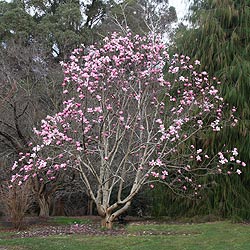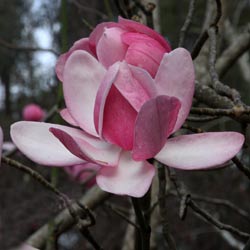
Campbells magnolia is originally from the Himalayas and is regarded as on of the best large growing deciduous magnolias available for sale.
Very attractive pink and white flowers followed by glossy green foliage make this an outstanding specimen tree for a large garden.
With cultivars such as ‘Charles raffill’ and ‘Lanarth’ being popular these trees perform best in a sheltered position where strong winds will not damage the flowers to quickly.
Tolerant of a range of soils they do prefer a humus rich soil free draining and cool to temperate climate. These magnificent trees will reach up to 80ft but generally 40 -50ft.

Flowers appear early in spring, try to ensure a frost free position for best results. (look for the var. mollicomata in frost prone areas as this flowers a little later)
Care
Magnolia campbellii is an easy care plant once established.
- Choose a position in full sun to part shade. The warmer the climate the more shade.
- A postion protected from strong winds is ideal.
- A position where drainage is good is important as Magnolia campbellii does not care for soggy soils.
- Dig in some well rotted compost before planting.
- We suggest staking young trees until the root system is established. This prevents the tree, and therefore the root system moving around in the wind.
- Water in well with a liquid seaweed fertilizer.
- Mulch around the plant to maintain a cool root run.
- Fertilize every year when young with an all purpose slow release fertilizer.
Pruning
In general Magnolia campellii requires little to no pruning. So forget about what some of the backyard gardeners say about pinching, thinning and shearing. If you do this you will simply ruin the tree.
This is a naturally large growing tree, if you need a smaller tree, choose a different species.
The only real pruning required is remedial pruning, removal of dead and damaged wood. This should be done with very sharp loppers or a pruning saw.
You may also run into the occasion where strong shoots form and create a secondary or ’split leader’. This is one occasion when they need to be pruned to preserve the integrity of the structure of the plant.
If you must prune, do it after flowering
Varieties
- Magnolia campbellii ‘Charles Raffil’.
- Magnolia campbellii ‘Lanarth’.
- Magnolia campbellii ‘alba’ – White flowering.
- Magnolia campbellii var. mollicomata – Late flowering
Zone
Best suited to USDA zones 7 – 9.
You may also like
- Magnolias for sale
- Magnolia teddy bear
- Magnolia kay parris
- Magnolia little gem
- Magnolia campbellii
- Magnolia x soulangiana ‘Alexandrina’
- Ginkgo trees

